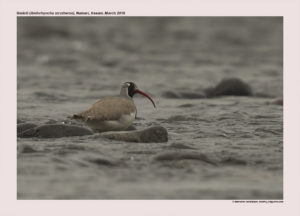Ibisbill

Ibisbill Ibidorhyncha struthersii
Etymology:
- Ibidorhyncha : Greek word ibidos – ibis; rhunkhos- bill
- Struthersii: Named after Scottish doctor Dr John Struthers (fl. 1855)
Vernacular Names : Miri hills: Puggah
Distribution in India: Resident of Himalayas and widespread winter Visitor in North and North East of India.
Description: Size of 39–41 cm; wt. of 270–320 g; bill length 68–82 mm; wingspan of 74 cm. It is an unmistakable wader with long, decurved brown to crimsonbilldepending on age and contrasting plumage, principally grey-brown above with white underparts relieved by black breast band. It has a distinctive head pattern, with black face and crown narrowly bordered white, and rest of head and neck are blue-grey. The legs are greyish purple to red. The Female is similar to male, but marginally larger with slightly longer bill, although this is only likely to be appreciable in side-by-side comparison. In flight, short tail with incomplete dark, narrow terminal band. The feet do not project beyond tail tip and largely grey wings with a variable white oval on inner and, to lesser extent, central primaries. The non-breeding adult has white-streaked black face. Juvenileare browner, with plumage pattern much less clearly marked.
Habitat: It breeds in shingle-bed mountain river valleys usually devoid of any vegetation, at 500–4400 m. It occupies same habitat in winter, but at lower altitudes, occurring down to 100 m in places.
Food habits : It eats aquatic river invertebrates like stoneflies, larvae of mayflies, caddisflies, beetles and crustaceans and fish. It forages by pecking, probing and raking, usually while wading in water roughly reaching up to belly. It forages singly, rarely in pairs, but can be found in loose flocks.
Breeding habits: They breed in Apr to Jun in Himalayas and China and March in Bhutan. They are monogamous and territorial, with territories occupied for years. The nest is a shallow pit on the ground, sometimes with lining of pebbles. They lay a clutch of 3-4 eggs. The incubation is done by both sexes. The young start to fly when 45–50 days old, and stay with parents until first winter.